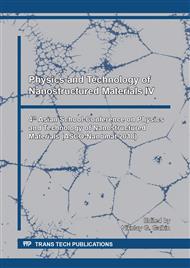[1]
Sinibaldi, Edoardo, et al. Magnetic nanofilms for biomedical applications. Journal of Nanotechnology in Engineering and Medicine 1.2 (2010): 021008.
Google Scholar
[2]
Pankhurst, Q. A., et al. Progress in applications of magnetic nanoparticles in biomedicine. Journal of Physics D: Applied Physics 42.22 (2009): 224001.
Google Scholar
[3]
Laurent, Sophie, et al. Magnetic fluid hyperthermia: focus on superparamagnetic iron oxide nanoparticles. Advances in colloid and interface science 166.1 (2011): 8-23.
DOI: 10.1016/j.cis.2011.04.003
Google Scholar
[4]
Alexis, Frank, et al. Nanoparticle technologies for cancer therapy. Drug delivery. Springer Berlin Heidelberg, 2010. 55-86.
Google Scholar
[5]
5. Murthy, Shashi K. Nanoparticles in modern medicine: state of the art and future challenges. International journal of nanomedicine 2.2 (2007): 129.
Google Scholar
[6]
Sinibaldi, Edoardo, et al. Magnetic nanofilms for biomedical applications. Journal of Nanotechnology in Engineering and Medicine 1.2 (2010): 021008.
Google Scholar
[7]
Engels, Elette, et al. Optimizing dose enhancement with Ta 2 O 5 nanoparticles for synchrotron microbeam activated radiation therapy.PhysicaMedica 32.12 (2016): 1852-1861.
DOI: 10.1016/j.ejmp.2016.10.024
Google Scholar
[8]
Brown, Ryan, et al. High‐Z Nanostructured Ceramics in Radiotherapy: First Evidence of Ta2O5‐Induced Dose Enhancement on Radioresistant Cancer Cells in an MV Photon Field. Particle & Particle Systems Characterization 31.4 (2014): 500-505.
DOI: 10.1002/ppsc.201300276
Google Scholar
[9]
Lin, Hong-Yi, Wei-Yu Chen, and Yu-Chie Chen. Iron oxide/tantalum oxide core–shell magnetic nanoparticle-based microwave-assisted extraction for phosphopeptide enrichment from complex samples for MALDI MS analysis. Analytical and bioanalytical chemistry 394.8 (2009).
DOI: 10.1007/s00216-009-2890-x
Google Scholar
[10]
Steblevskaya N.I., Belobeletskaya М.V., Medkov М.А., Lukyanenko К.S., Apanasevich V.I., Lukyanov P.А., Lagureva А.V., Plotnikova O.S., Kustov V.N. The application for the patent of the Russian Federation №2016132930 from 9.08.2016 (priority). Method of obtaining magnetoactive radiocontrast agent.
Google Scholar
[11]
Mitchell, J., R. T. Knight, and K. Kimlin. Effects of iodinated contrast media on radiation therapy dosimetry for pathologies within the thorax. Radiographer: The Official Journal of the Australian Institute of Radiography, The 53.2 (2006): 30.
DOI: 10.1002/j.2051-3909.2006.tb00053.x
Google Scholar
[12]
Gneveckow, U., et al. Magnetic force nanotherapy. Biomed. Tech 50 (2005): 92-93.
Google Scholar


